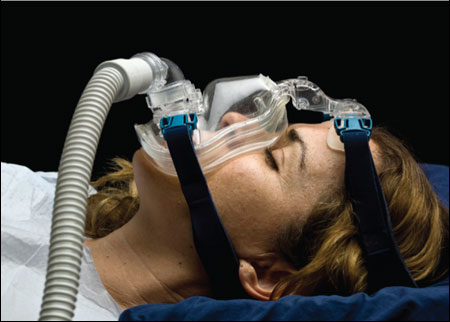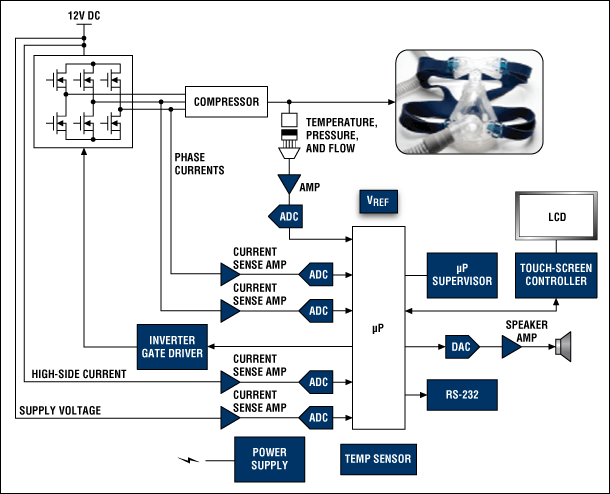How Continuous Positive Airway Pressure (CPAP) Respiratory Ventilation Systems Function
摘要
This application note introduces how a continuous positive airway pressure (CPAP) ventilation system operates. The main subfunctions of CPAP respiratory ventilation include air-hose-environment sensing, compressor motor-drive feedback, motor-drive excitation, and a communication interface to a technician/doctor. These subfunctions are explained and a functional block diagram showing system components is also detailed.
Continuous positive airway pressure (CPAP) is a type of respiratory ventilation originally developed for combating sleep apnea, which remains its primary use. It is also useful in providing ventilation for newborns and anyone suffering respiratory failure.
As airway muscles relax during sleep, the airway can become partially obstructed. This can lead to lower blood oxygenation and cause awakening or arousal from deep sleep. Maintaining positive air pressure by supplying a continuous source of compressed air, the face mask forms a seal to the face. It is only this air pressure that maintains the open airway, and not the actual movement of air. A sleep physician usually determines the required air pressure after completing a sleep study.
Pressure sensors supply feedback of the applied air pressure in the mask/delivery hose to the microprocessor controller. This microprocessor controller manages the motor-drive stage of a compressor to maintain the correct fan velocity necessary to generate the required air pressure.

The main subfunctions that the system is required to monitor and control can be divided as follows:
- Air-hose-environment sensing This covers air pressure, but may also include air temperature, humidity, and flow rate.
- Compressor motor-drive feedback Similar to all motor-drive systems, some feedback must be provided to maintain torque and/or velocity control. Typically, phase currents or shunt current and rotor feedback must be provided.
- Motor-drive excitation This is the generation of the waveforms necessary to both induce current in the electric motor and produce the torque that causes motion.
- Communication interface to technician/doctor This requires the ability to display information as well as input commands and controls from the medical team. This can include LCD drivers and touch-screen controllers, as well as a means for audio communication alerts, such as beeps and tones.

Functional block diagram of a CPAP system.
Given the time and expense required to achieve FDA approval, manufacturers must select a supplier with a customer-oriented discontinuance policy to ensure that system components will be available for many years.
Medical customers rely on Maxim products because, over the years, we have carefully avoided discontinuing parts. We realize how devastating product discontinuance can be to a customer, so we work diligently to transfer some products to newer production lines, create wafer buffers, allow last-time purchases, or develop upgrade devices. Very few Maxim parts have ever been discontinued while demand still existed.
关联至此文章
产品
量产
±15kV ESD保护、电流低至10nA、3.0V至5.5V供电、速率高达1Mbps的真RS-232收发器
过期
低功耗、超小尺寸电阻式触摸屏控制器,提供I²C/SPI接口
不推荐用于新设计
低功耗、超小尺寸电阻式触摸屏控制器,提供I²C/SPI接口
高效、1.5MHz运算放大器,提供RRIO
1µA、4焊球UCSP/SOT23封装、高精度电流检测放大器
-20V至+75V输入范围、高精度单/双向电流检测放大器
超低失调/漂移、低噪声、高精度、SOT23封装放大器
超高精度、高边电流检测放大器
12位、300ksps ADC,带有FIFO、温度传感器及内部电压基准
12位、300ksps ADC,带有FIFO、温度传感器及内置电压基准
高精度、微功耗、低压差、SC70串联型电压基准
超低功耗、串联型电压基准
低成本、立体声音频DAC
16位、单声道音频编解码器
精度为±0.5°C、模拟输出温度传感器
高精度数字温度计和温度监控器
数字温度传感器和温度调节器
采用2mm x 2mm TDFN封装的低噪声500mA LDO稳压器
可编程、四串HB LED驱动器,可优化输出电压,并具有故障检测
集成4通道、高亮度LED驱动器,提供高压DC-DC控制器
集成2通道、高亮度LED驱动器,具有高压boost和SEPIC控制器
125nA监控电路,提供电容可调的复位和看门狗超时周期
2.2MHz、3A buck或boost转换器,集成高边开关
TacTouch™、低功耗、超小尺寸、电阻式触摸屏控制器,带有触觉驱动器
低功耗、超小尺寸电阻式触摸屏控制器,提供I²C/SPI接口
低功耗、超小尺寸电阻式触摸屏控制器,提供I²C/SPI接口
行业解决方案
{{modalTitle}}
{{modalDescription}}
{{dropdownTitle}}
- {{defaultSelectedText}} {{#each projectNames}}
- {{name}} {{/each}} {{#if newProjectText}}
-
{{newProjectText}}
{{/if}}
{{newProjectTitle}}
{{projectNameErrorText}}



















